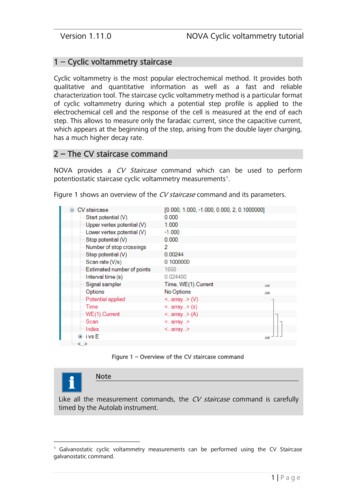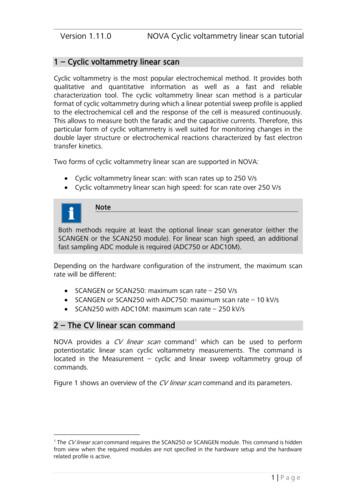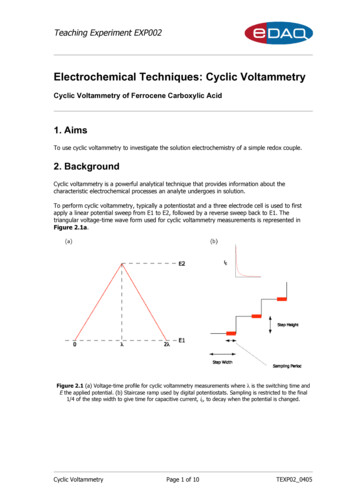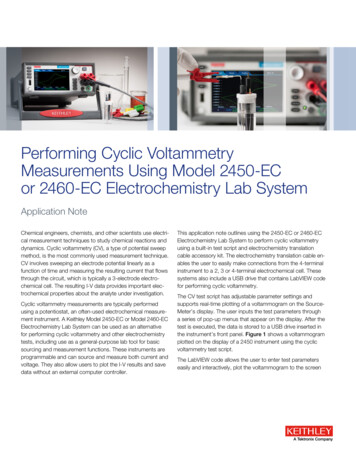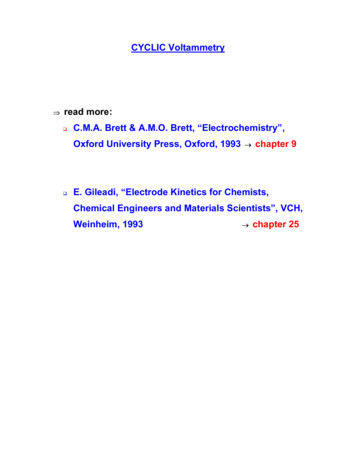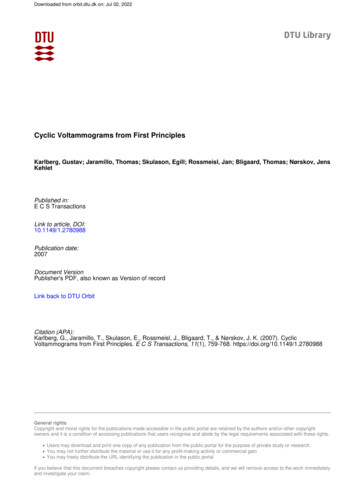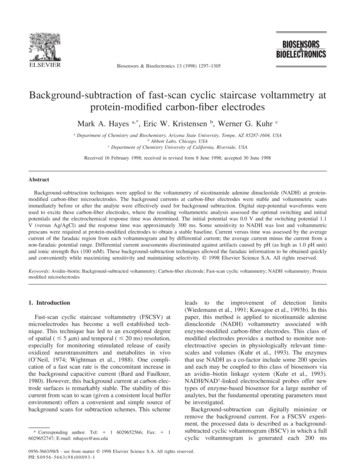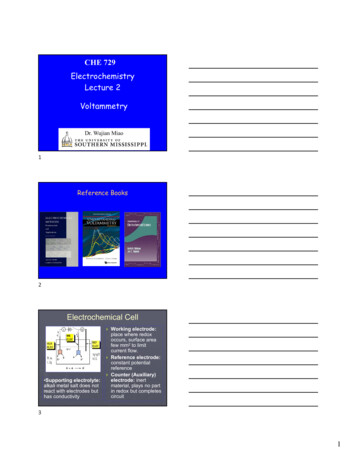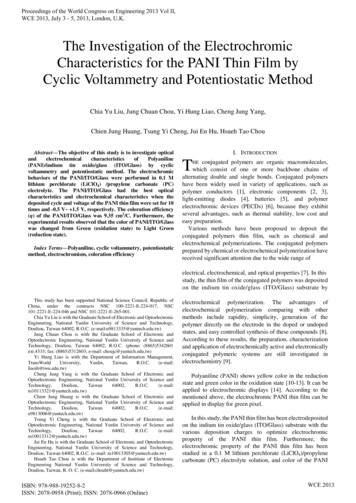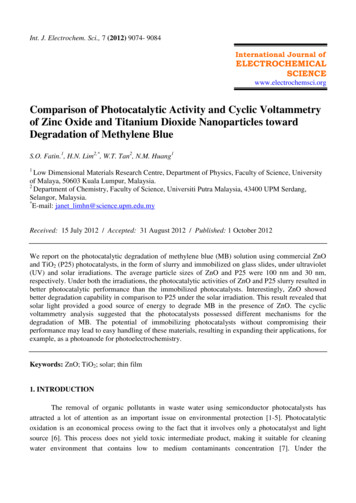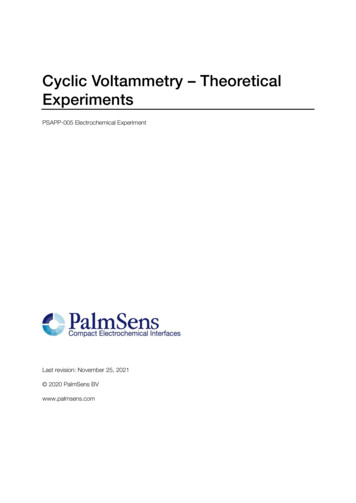
Transcription
Cyclic Voltammetry – TheoreticalExperimentsPSAPP-005 Electrochemical ExperimentLast revision: November 25, 2021 2020 PalmSens BVwww.palmsens.com
Cyclic Voltammetry – Theoretical Experiments2Instructions
Cyclic Voltammetry – Theoretical Experiments1 InstructionsThe following instructions will guide you to perform the experiment. The theory on which theseexperiments are based, can easily be checked online at palmsens.com, then search for “Introduction toCyclic Voltammetry”. The material needed for the experiments can be ordered t/#contents2 Devices and Equipment EmStat / EmStat Bluesensor cablesensor connectormaybe a USB cablecomputing unit (PC, Laptop, notebook, tablet PC (Android), smartphone (Android))potentiostat software (PStrace, PStouch)calculation and plotting software (Excel, Origin, MatLab, Mathematica)counter electrodereference electrodeworking electroderetort standretort clampbeaker (electrochemical cell)stirrergas source (optional)3 Chemicals 0.1 M KCl solution (prepared from solid KCl and demineralized water) for preparation ofK3[Fe(CN)6] and K4[Fe(CN)6] solutions Mixed K3[Fe(CN)6] and K4[Fe(CN)6] in 0.1 M KCl solutions with ratios of K3[Fe(CN)6]/K4[Fe(CN)6] 100/1, 10/1, 1/1, 1/10, 1/100 (hint 1: All these solutions should have the same sum ofconcentrations, that is c(K3[Fe(CN)6]) c (K4[Fe(CN)6]) constant; hint 2: A concentration for allsolutions of (0.010 0.001) M can be achieved by using 0.1 M solutions of K3[Fe(CN)6] andK4[Fe(CN)6] in 0.1 M KCl with a pipette (20 ml) and variable microliter pipettes (10 - 100 µl and100 – 1000 µl).) 0.1 M solutions of K3[Fe(CN)6] in 0.1 M KCl 0.1 M solutions of K4[Fe(CN)6] in 0.1 M KClNote: If you use the 50 mL beaker, you will need 40 mL of solution for your measurement. Werecommend using a smaller vessel that allows the electrodes to be immersed in 5 mL solution for theenzyme catalysis experiment.Instructions3
Cyclic Voltammetry – Theoretical Experiments4 Instructions4.1 Determination of the Formal Potential1. Make K3[Fe(CN)6] and K4[Fe(CN)6] in 0.1 M KCl solutions with ratios of K3[Fe(CN)6]/K4[Fe(CN)6] 100/1, 10/1, 1/1, 1/10, 1/1002. Choose from the techniques drop down menu the Potentiometry / OCP. Choose 300 s as t run(duration of the measurement) and 1 s as t interval (time between measurement points).3. Immerse all three electrodes (reference, counter, and working electrode) into each one of thesolutions. Press start and wait until the open circuit potential is stable. Note the solution ratio andthe corresponding open circuit potential. Stop the measurement.4. Repeat step 3 for each of the solutions. Rinse the electrodes carefully between changing thesolutions.5. Prepare a 5 mM K4[Fe(CN)6] in 0.1 M KCl solution, for example by adding 1 mL of 0.1 MK4[Fe(CN)6] in 0.1 M KCl solution to 19 mL of 0.1 M KCl solution.6. Fill the cell with the 5 mM solution. Immerse the three electrodes into the solution. If a method forperforming a CV was already prepared for you load the method. If not choose CyclicVoltammetry from the drop down menu. Choose the current ranges 1 µA, 10 µA, and 100 µA.The fields Sample and Sensor are for your own notes. Since we do not want a pre-treatment ofthe electrode set t condition and t deposition to 0. Set the other parameters to:a. t equilibrium 8 sb. E start 0 mVc. E vertex1 0 mVd. E vertex2 500 mVe. E step 0.001 Vf. Scan rate 0.05 V/sg. Number of Cycles 37. Start the measurement. Save the curve afterwards under the menu Curve.8. Determine the formal potential from both measurements.a. Potentiometry: The formal potential from the open circuit potentials can be determinedvia the Nernst equation (equation 4.1).𝐸 𝐸 0′ 0.059 �When the ratio of cOx and cRed is 1/1 the log will be 0 and the potential E is equal to theformal potential E0’. A good way to determine the formal potential is to plot E versuslog cOx/cRed. A linear fit can be made and the E value at log cOx/cRed 0 is the formalpotential.b. Voltammetry: Due to the fact that [Fe(CN)6]4- and [Fe(CN)6]3- have the same diffusioncoefficient, determining the formal potential is simple. Read the peak potentials for theanodic and cathodic peaks Ep,a and Ep,c from the CV. Their average is the formalpotential.4.2 Identification of a Reversible, Quasi-reversible, or IrreversibleSystem1. Prepare a 5 mM K4[Fe(CN)6] in 0.1 M KCl solution, for example by adding 2 mL of 0.1 MK4[Fe(CN)6] in 0.1 M KCl solution to 38 mL of 0.1 M KCl solution.2. Fill the cell with the 5 mM solution. Immerse the three electrodes into the solution. If a method forperforming a CV was already prepared for you load the method. If not choose CyclicVoltammetry from the drop down menu. Choose the current ranges 1 µA, 10 µA and 100 µA.The fields Sample and Sensor are for your own notes. Since we do not want a pre-treatment ofthe electrode set t condition and t deposition to 0. Set the other parameters to:a. t equilibrium 8 sb. E start 0 mVc. E vertex1 0 mV4Instructions
Cyclic Voltammetry – Theoretical Experimentsd. E vertex2 500 mVe. E step 0.001 Vf. Scan rate 0.005 V/sg. Number of Cycles 33. Start the measurement. Save the curve under the menu Curve.4. Repeat the measurement with a Scan rate of 0.01 V/s, 0.025 V/s, 0.05 V/s, 0.1 V/s, 0.25 V/s,and 0.5 V/s. Save each curve.5. The goal is to use Table 4.1 to identify if [Fe(CN)6]4- and [Fe(CN)6]3- is a reversible, quasireversible, or irreversible system. Using the list of criteria different parameters need to beextracted from the CV and compared.Table 4.1: diagnostic criteria for reversible, quasi-reversible and electrochemical irreversible systemsReversible Ep (Ep,a-Ep,c) 59 mV/z(298K)Quasi-reversible Ep (Ep,a-Ep,c) f(v)Electrochemical irreversibleEp shift about 30 mV/ z (298 K)with tenfold higher v( unknown factor)E0 0,5 (Epa Epc) (DOx DRed)E0 0,5 (Epa Epc) (DOx DRed)Ip,a v1/2Ip,a v1/2Ip,a const1 v1/2Ip,a const2 v1/2Ip,a/Ip,c 1 for all vIp,a/Ip,c 1 for all vOne peak current (Ip,c) missingExtracting the Ip,c is not directly possible due to the fact that there is no direct baseline available.When the scan rate is inversed there is still current flowing due to conversion of the [Fe(CN)6] 4-.The current overlaps with the baseline of the cathodic sweep, so either a graphical ormathematical extrapolation has to be done. The graphical method is rather difficult, since parts ofthe curve has to be guessed. The mathematical way just needs a single equation and someparameters from the curve. Determine Ip,c,0 and Ivertex according to Figure 4.1 and use equation4.2 to determine Ip,c. 𝐼𝑝,𝑐 𝐼𝑝,𝑐,0 0.485 𝐼𝑣𝑒𝑟𝑡𝑒𝑥 0.086 𝐼𝑝,𝑎 4.2Discuss which system [Fe(CN)6]4- and [Fe(CN)6]3- is.Figure 4.1: scheme of a CV indicating how to determine Ip,c,0 and IvertexIn these experiments you determined the formal potential and identified reversible, quasireversible and irreversible systems using cyclic voltammetry.Please note that teachers can request the answers to the question in the instructions, 5
Cyclic Voltammetry - Theoretical Experiments 1 Instructions The following instructions will guide you to perform the experiment. The theory on which these experiments are based, can easily be checked online at palmsens.com, then search for "Introduction to Cyclic Voltammetry". The material needed for the experiments can be ordered via
